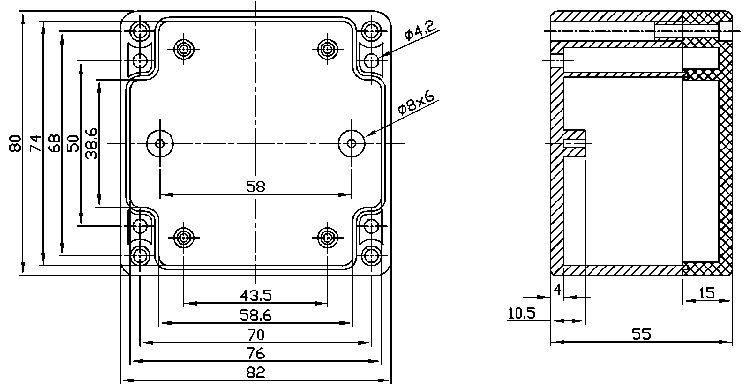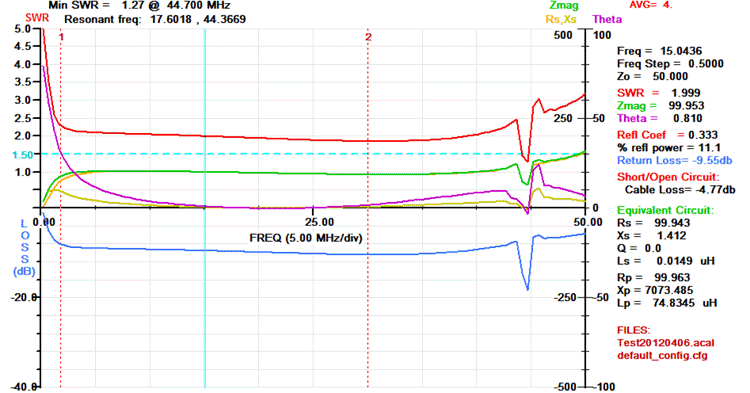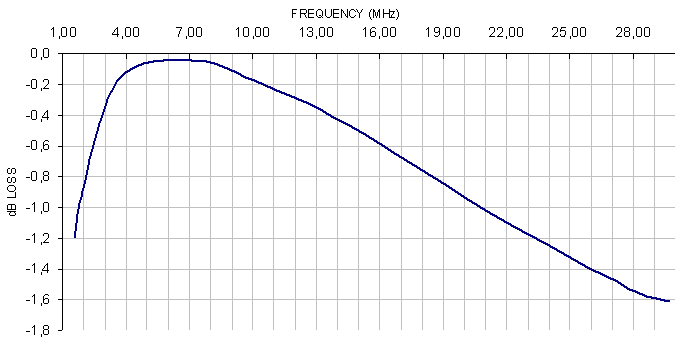четверг, 26 июня 2014 г.
четверг, 19 июня 2014 г.
| 1:1 VOLTAGE BALUN |
| 1:1 Ruthroff voltage balun. Install July 2012. |
Construction
The T-200-2 powdered iron toroid core was tightly rapped in a lay of overlapping PVC electrical tape to prevent the enamelled copper wire's insulation being damaged during winding and to offer some additional electrical insulation with core.
The triple bifilar winding of 17 turns are wound evenly spaced around the toroid core with the two individual windings wound close together.
The length of enamelled copper wire per winding for the T-200-2 powdered iron toroid core is determined by length per winder = 50mm per turn plus 200mm tails
The exact number of turns is not critical but the numbers listed in the preceding table should yield good results. It is possible to exceed the power ratings listed above but the performance of the balun may be degraded during high SWR causing heating of the core.

Figure 1 Schematic of the 1:1 Ruthroff voltage balun. Typically unbalanced = 50/75 ohms and balanced = 50/75 ohms.

Figure 2 Wiring of the 1:1 Ruthroff voltage balun.
Table 1 lists alternative toroid core with winding suggestions.
Parts list.

Figure 3 Sealed Polycarbonate Enclosures 82 x 80 x 55mm details

Photo 1 1:1 Ruthroff voltage balun assembled.
The evaluation of the efficiency of the balun over the desired bandwidth (1.8 - 30MHz) was carried out by testing the impedance that could be seen from unbalanced side to a resistive load applied to the balanced side using an antenna analyser. The efficiency is shown to cut of sharply below 1.8MHz and gradually taper of above about 40MHz. The below antenna analyser plot viewing a 100ohm resistive load attached to the balanced side of the balun and measured at a nominal impedance of 50ohms presented as anticipated an approximate 100ohm load to the analyser and produced about a 2:1 SWR. Despite not having carried out this test previously the results are more or less what was expected and demonstrates that the balun's 1:1 voltage transformation occurs efficiently from 1.8 to well above 30MHz

Figure 4 AIM 4170C antenna analyser plot viewing a 100ohm resistive load through the Ruthroff voltage balun. Note the 100ohm resistor appears as 100ohms due to the 1:1 balun ratio resulting in an ideal SWR of 2:1. (1) = 1.8MHz & (2) = 30.MHz.
AIM 4170C antenna analyser explanation;
An additional evaluation of the efficiency of the balun was preformed by simply measuring the RF power at selected frequencies fed into the balun and measuring the out put power from the balun using the set up shown in Figure 7.
For example, RF was applied to the input of the Balun at a frequency of 1.8 MHz at a power of 5 Watts with 4 Watts being measured at the output meter. The below formula was applied revealing a Balun loss of 0.97dB at this frequency.

Figure 5 shows the results of measurements taken at various frequencies including the calculated loss. Figure 6 shows the graphed results of the losses verses frequency.
Concussion of this evaluation is that the efficiency between 3.5 MHz to 14 MHz is very high as to be unnoticeable and that even at 28 MHz the loss would represent only about half an ‘S’ point.
The limitation of this evaluation is that it is under an ideal situation of 50 ohms and that more extreme loads will likely show greater losses.
Figure 5 Table of test results.

Figure 6 Plot of Balun losses verses frequency.
Figure 7 Efficiency evaluation set up.
|
| 9:1 VOLTAGE UNUN |
| 9:1 voltage unun. |
Requiring a unun to feed a long wire antenna ideally without a tuner a 9:1 voltage unun design using a T200-2 Toroid core was selected.

Figure 1 Typical 9:1 voltage unun and long wire antenna configuration.
Construction
PVC covered 1mm diameter copper wire was used with the view that the thicker insulation may reduce the possibility of insulation puncture due to the higher nominal impedance. The triple bifilar winding of 10 turns are wound evenly spaced around the T-200-2 powdered iron toroid core with the three individual windings wound close together. The length of enamelled copper wire per winding for the T-200-2 powdered iron toroid core is determined by length per winding = 50mm per turn plus 250mm tails
Figure 2 Schematic of the 9:1 voltage unun. Typically unbalanced = 50/75 ohms too unbalanced = 450/675 ohms.
Figure 3 Wiring of the 9:1 voltage unun.
Table 1 Toroid core with winding suggestions.
Parts list.
 
Photo 1 9:1 voltage unun assembled.
The evaluation of the efficiency of the unun over the desired bandwidth (1.8 - 30MHz) was carried out by testing the impedance that could be seen from transceiver side unun to a resistive load applied to the antenna side using an antenna analyser. The efficiency is shown to cut of sharply below 5MHz and gradually taper off at about 30MHz. The below antenna analyser plot viewing a 450ohm resistive load attached to the balanced side of the balun and measured at a nominal impedance of 50ohms presented as anticipated an approximate 50ohm load to the analyser and produced about a 1:1 SWR. Despite not having carried out this test previously the results are more or less what was expected and demonstrates that the unun's 1:9 voltage transformation occurs efficiently from 7 to 25MHz. The results are not as satisfying as those carried out on the 1:1 voltage balun showing significant reactance across the band. The results are less than ideal and the application of the design is to be reviewed, but is useful over a limited frequency range from 7MHz to 25MHz,
Figure 5 AIM 4170C antenna analyser plot viewing a 450ohm resistive load through the unun. Note the 450ohm resistor appears as 50ohms due to the 9:1 unun ratio resulting in an ideal SWR of 1:1.
AIM 4170C antenna analyser explanation;
An additional evaluation of the efficiency of the unun was preformed by simply measuring the RF power at selected frequencies fed into the balun and measuring the out put power from the balun using the set up shown in Figure 8. In this set up it was necessary to have two identical 9:1 ununs, the second to step the impedance back down to the 50 ohms for measuring. It is critically important that the two ununs be made in a identical fashion as the results need to assume that half the losses are as a result of each of the ununs as that the below formula simply halves the resultant overall loss.

Figure 6 shows the results of measurements taken at various frequencies including the calculated loss. Figure 7 shows the graphed results of the losses verses frequency.
Concussion of this evaluation is that the efficiency between 8.0 MHz to 25 MHz is very low as to be unnoticeable and that even at 25 to 30 Mhz the loss would be almost unnoticeable however the losses are high at 3.5 MHz representing a full 'S' point drop or half the power being lost in the unun. At 1.8 MHz the losses are very high at -5.2 dB, almost 2 'S' points. This unun should be useful from 7.0 MHz to 30 MHz and at push on 3.5MHz if nothing better was avaliable.
The limitation of this evaluation is that it is under an ideal situation of 50 ohms and that more extreme loads will likely show greater losses.
 Figure 7 Plot of Balun losses verses frequency. Figure 8 Efficiency evaluation set up. |
| 4:1 VOLTAGE BALUN |
| 4:1 Ruthroff voltage balun. Install July 2012. |
Construction
The double bifilar winding of 17 turns are wound evenly spaced around the toroid core with the two individual windings wound close together. The length of enamelled copper wire per winding for the T-200-2 powdered iron toroid core is determined by length per winder = 50mm per turn plus 200mm tails The exact number of turns is not critical but the numbers listed in the preceding table should yield good results. It is possible to exceed the power ratings listed above but the performance of the balun may be degraded during high SWR causing heating of the core. 
Figure 1 Schematic of the 4:1 Ruthroff voltage balun. Typically unbalanced = 50/75 ohms and balanced = 200/300 ohms.

Figure 2 Wiring of the 4:1 Ruthroff voltage balun.
Table 1 lists alternative toroid core with winding suggestions.
Parts list.

Figure 3 Sealed Polycarbonate Enclosures 82 x 80 x 55mm details

Photo 1 4:1 Ruthroff voltage balun assembled.
The evaluation of the efficiency of the balun over the desired bandwidth (1.8 - 30MHz) was carried out by testing the impedance that could be seen from unbalanced side to a resistive load applied to the balanced side using an antenna analyser. The efficiency is shown to cut of sharply below 1.8MHz and gradually taper of above about 30MHz. The below antenna analyser plot viewing a 100ohm resistive load attached to the balanced side of the balun and measured at a nominal impedance of 50ohms presented as anticipated an approximate 25ohm load to the analyser and produced about a 2:1 SWR. Despite not having carried out this test previously the results are more or less what was expected and demonstrates that the balun's 1:4 voltage transformation occurs efficiently from 1.8 to 30MHz. The results are not as satisfying as those carried out on the 1:1 voltage balun showing significant reactance across the band. Despite the less than ideal analyser plot the balun appears to work well as an interface between the T-Match tuner and the balanced multi-band antenna system.

Figure 4 AIM 4170C antenna analyser plot viewing a 100ohm resistive load through the Ruthroff voltage balun. Note the 100ohm resistor appears as 25ohms due to the 4:1 balun ratio resulting in an ideal SWR of 2:1. (1) = 1.8MHz & (2) = 30.MHz.
AIM 4170C antenna analyser explanation;
An additional evaluation of the efficiency of the balun was preformed by simply measuring the RF power at selected frequencies fed into the balun and measuring the out put power from the balun using the set up shown in Figure 7. In this set up it was necessary to have two identical 4:1 baluns, the second to step the impedance back down to the 50 ohms for measuring. It is critically important that the two baluns be made in a identical fashion as the results need to assume that half the losses are as a result of each of the baluns as that the below formula simply halves the resultant overall loss.
For example, RF was applied to the input of the Balun at a frequency of 1.8 MHz at a power of 5 Watts with 1.95 Watts being measured at the output meter. The below formula was applied revealing a Balun loss of 2.0dB at this frequency per bulun.

Figure 5 shows the results of measurements taken at various frequencies including the calculated loss. Figure 6 shows the graphed results of the losses verses frequency.
Concussion of this evaluation is that the efficiency between 3.0 MHz to 30 MHz is very low as to be unnoticeable and that even at 1.8 Mhz the loss would represent less than an ‘S’ point being almost unnoticeable.
The limitation of this evaluation is that it is under an ideal situation of 50 ohms and that more extreme loads will likely show greater losses.
 Figure 6 Plot of Balun losses verses frequency. Figure 7 Efficiency evaluation set up.
Also see 1:1 Ruthroff voltage balun. and 1:9 voltage unun.
|
четверг, 5 июня 2014 г.
How to connect to ScoutLink
IRC
There are different ways you can connect to ScoutLink. If you already have an IRC-Client or you want to install one then just enter the data provided, and connect. If you do not know how to install an IRC-Client or how to enter the data just look at our configure mIRC page.
If you think that all is to complicated then just start with one of our webchats.
If you think that all is to complicated then just start with one of our webchats.
Here is the info you need for your IRC-Client
Networkname: ScoutLink
Port: 6667
Server: chat.scoutlink.net
Port: 6667
Server: chat.scoutlink.net
Here is an example how it could look on mIRC.

There are a lot of servers, please choose one near to your location. The following list shows you the names of servers near to you. Using one of them always connects you to a server in your region. If you do not know what to choose just take chat.scoutlink.net. Port is always 6667
| chat.scoutlink.net | Connects you to a random server |
| chat.eu.scoutlink.net | Use this if you are somewhere in Europe |
| chat.nl.scoutlink.net | Use this if you are from The Netherlands |
| chat.de.scoutlink.net | Use this if you are from Germany |
Secure IRC (IRC-SSL)
All of our servers have SSL enabled. Using SSL encrypts your connection to the server, so that no one between you and the server could read the data you are sending. Our port for secure IRC is 6697. All Servers support ssl.
You have to tell your client that it trusts the SSL certificate, you also have to tell the client that it should use SSL. See the "configure client" section for more details. For mIRC you have to enter the port as "+6697".
TeamSpeak
ScoutLink is more than just text based chatting via IRC. We also offer a TeamSpeak Server and we hope to include other services in the future.
Information on how to setup your TeamSpeak client, so that you can talk to others, can be found at our TeamSpeak page.
Подписаться на:
Сообщения (Atom)